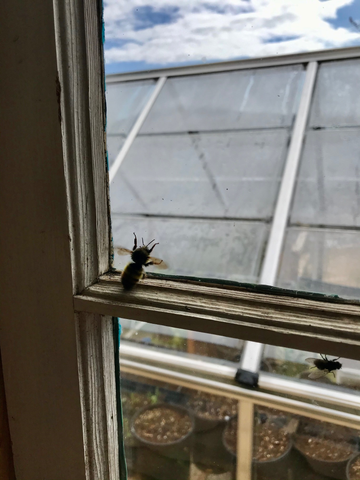BEE'S
University of Ottawa, Ontario Canada’s Conservation Biologist Peter Soroye (https://www.petersoroye.com) says researchers have discovered that bumble bees are disappearing at rates ‘consistent with a mass extinction.’ Peter warns ‘If declines continue at this pace, many of these species could vanish forever within a few decades". Sadly, Peter continues to say ‘We know that this crisis is entirely driven by human activities,’ Peter Soroye said.
The process of pollination happens when a pollinator (bee, bird, bug or butterfly to name a few) moves from one flower to another; this action produces fertile seeds. Some plants are pollinated naturally by wind or rain, and some are self-pollinating.
Pollen is important because it fertilizes a plant's eggs, and about 75% of flowering plants need to be pollinated so they can reproduce. Pollination begins with flowers. Flowers have male parts that produce very small grains called pollen. Many insects help move pollen between flowers and act as “pollinators”. Bees are an important beneficial pollinator and they provide one third of the food we eat!
Bees allow plants to reproduce, produce berries, and fruits we can eat and seeds that will create more plants. And, without bees, we are in serious trouble. Many of our wild bee populations have declined. Domestic honeybees are also struggling. This is due to three key factors: loss of native habitat, disease and pesticide use. These losses of our bee populations pose a serious risk to our food supply.

Canada has over 800 native bee species and globally there are roughly 20,000 known bee species worldwide and found on every continent except Antarctica, and the smallest bee is the size of the head of a pin. Every bee species is unique and pollinates different plants, at different times. The squash bee species for instance, are the best bees for squash, pumpkins and gourds, and all bee species are beneficial to our gardens.
Bees feed on nectar which is loaded with sugar and is their main source of energy and pollen which provides proteins and fats. We want to encourage our Bumbleseeds community to grow a mix of plants, including native ones and mix in pretty ones (eye candy for us but they may be sterile).
Did you know that bees see colour?
Yes! Bees especially like the colours blue, purple, violet, white and yellow. To get more bees in your garden you need to grow plants with more colour. Bees are more likely to live and thrive in urban backyard, community and patio gardens because these offer a variety of different plants - flowers, herbs and vegetables which creates a shorter flight path and requires less energy and distance for bees to gather pollen.
We want to encourage gardeners to plant single pollinator attractant species in clumps instead of scattering them around for aesthetics in smaller samplings as bees can pollinate more per square foot in less time, using less energy to travel, if the plants are planted in one area. Bees love blue and love cluster plants like lavender and rosemary.
Did you know that bees all have different tongue lengths?
Whenever possible, try to choose a variety of native pollinator plants; a wider variety of plants is a valuable source of food for a wider range of bee species. Another helpful tip: plants that flower at different times are so important - this ensures there is a constant supply of food available.

More Bee Facts…
- The largest bee in the hive is the Queen Bee; she can lay 2,000 eggs a day.
- All worker bees are female
- Fertilized eggs become females and unfertilized eggs become males, with the help of pheromones
- Male bees (drones) have bigger eyes to help them find the Queen Bee.
- Bees mate high in the sky. Afterwards the male bee loses his reproductive organs and dies.
- A bee produces a teaspoon of honey (about 5 grams) in her lifetime.
- The type of flower the bees take their nectar from determines the honey’s flavour.
- Typically bees have to fly over 55,000 miles to make one pound of honey; to produce a kilogram of honey, bees fly the equivalent of three times around the world in air miles
- Honey has been shown to have many health benefits both when eaten and when applied to the skin. The darker the honey the better.
- Bees don't want to sting you - because they will die.
- The bee is the only social insect to be partially domesticated by humans.
Let’s all do our part to make a difference and help bees survive and thrive again. Here’s what you can do:
- Create bee friendly areas and gardens
- Plant native plants as a food source.
- Keeping small areas of your backyard a little untidy and overgrown creates a safe habitat.
- Drill out holes in old stumps
- Have a source of water available; shallow dishes with a low beach entry area is good
By planting flowers and herbs and letting some of your plants go to seed helps the bees source the food they need and best of all, attracting more bees to your garden helps your garden absolutely flourish.
Buy Now!
The Bees Knees Pollinator Flower Garden Blend



